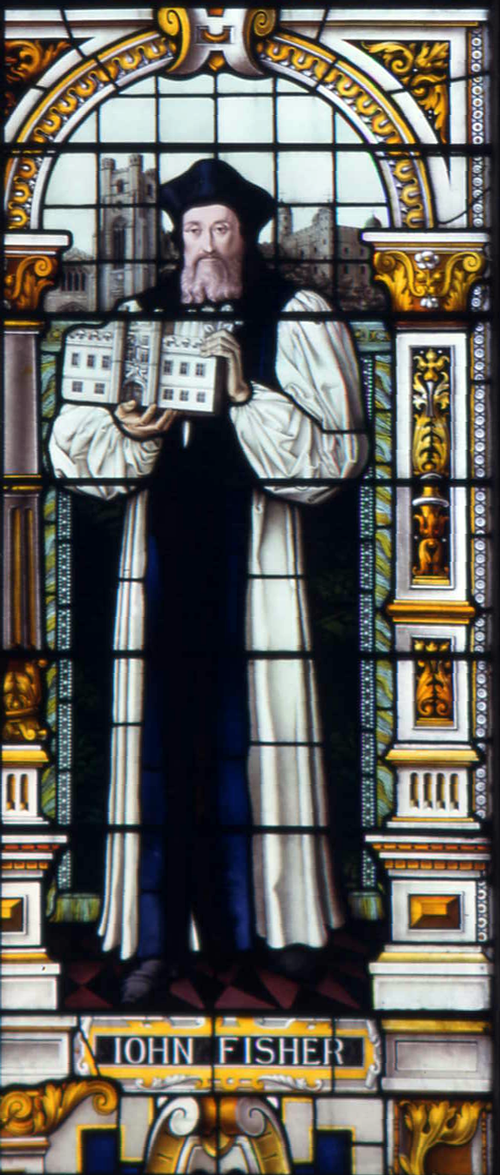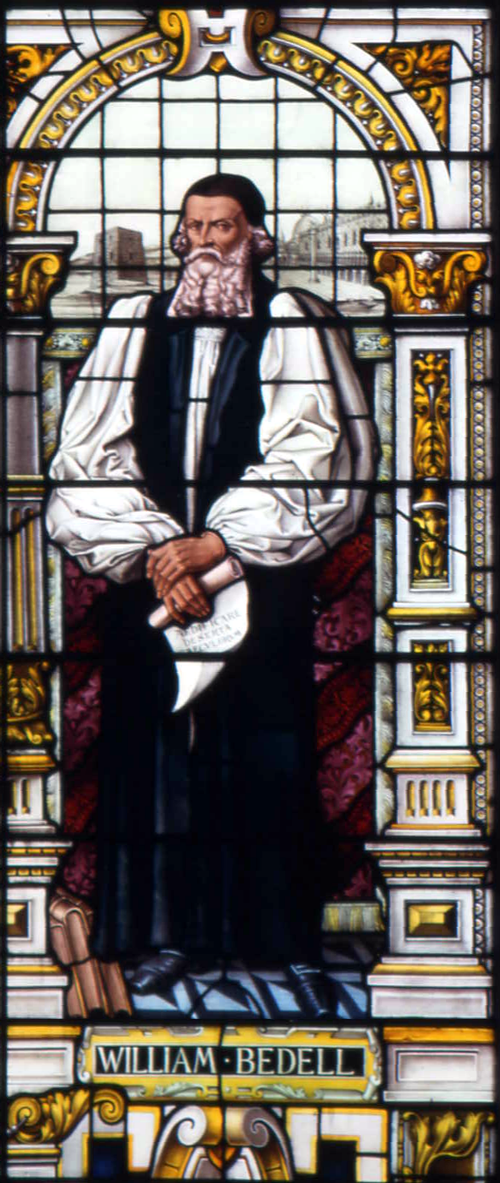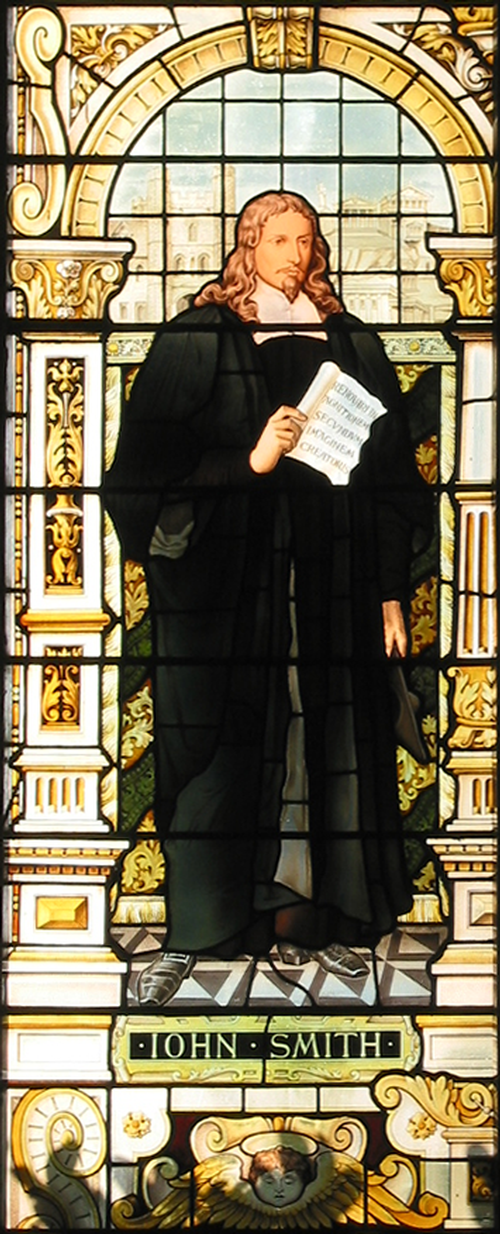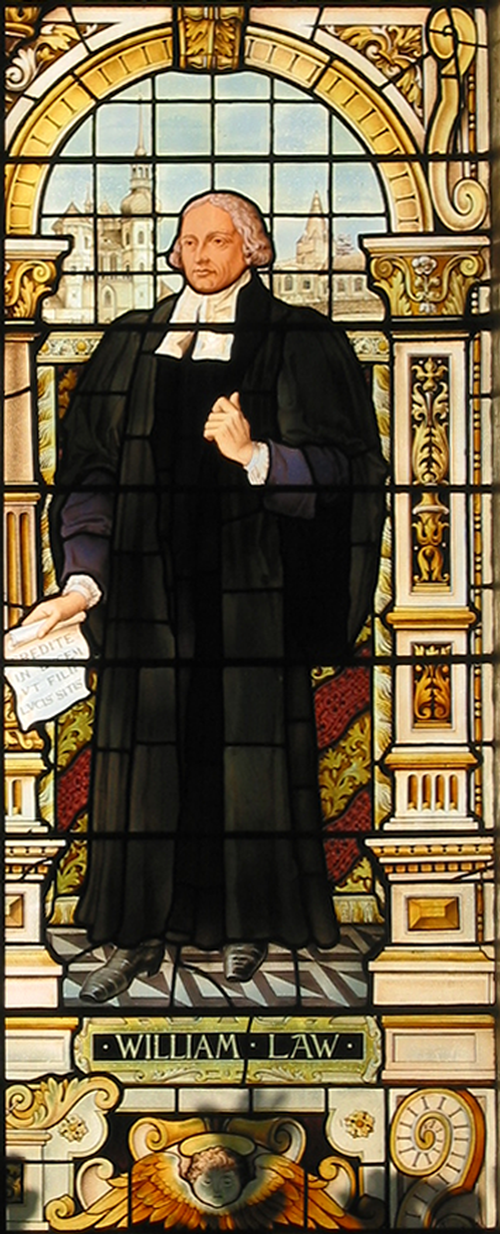
I like having a student-run bar,
because it keeps it friendly and cheap!
Frances, 2nd Year
The Chapel windows were originally plain. The present stained glass was executed by the firm of Heaton, Butler & Bayne. They were completed in 1884, as part of the commemoration of 300 years of Emmanuel.
Click on a window to get detailed descriptions of the figures depicted:
| East End (Altar) |
|---|
 |
St Augustine of Hippo
St Anselm |
Origen
John Eriugena |
 |
 |
John Fisher
Thomas Cranmer |
John Colet
William Tyndale |
 |
 |
Laurence Chaderton
John Harvard |
Benjamin Whichcote
Peter Sterry |
 |
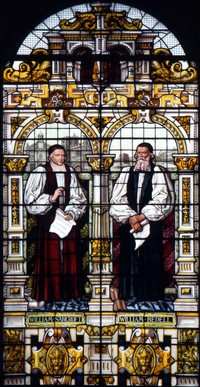 |
William Bedell
William Sancroft |
John Smith
William Law |
 |
| West End (Entrance) |
|---|
The History of the Windows
The windows' actual designer was most probably Clement John Heaton the younger (1861–1940). The general subject scheme was suggested by the Revd Hort (Fellow 1872–1892), who was a celebrated New Testament scholar. The basic intention was similar to that of the windows in Trinity College Chapel, although the scale is much smaller. Trinity's windows were planned a decade before by Hort's friends & colleagues there: Westcott and Lightfoot. The figures are chosen to illustrate the continuity of the history of the Church. The special part played in it by members of the College is also celebrated.
From east–west, the first window shows theologians of the early & middle ages. The opposite window shows two men of the English Reformation. It is said they might have belonged to Emmanuel, had it existed. The remaining four show theologians who actually were of Emmanuel. On the north side, they are men whose contributions were chiefly to the organisation of the Church, and to systematic theology. Those on the south to spiritual life & thought and to speculative theology. The plan exhibits a feeling for the Church as a unity, although this was less fashionable in the 1870s & 1880s than now. The Cambridge Platonists of the seventeenth–century are to be seen as the legitimate heirs of Origen & Eriugena. The Catholic John Fisher, and the Protestant Thomas Cranmer, both reformers (though in different ways) & martyrs, share a window.
St Augustine of Hippo c.334–430
St Augustine is shown holding his book De civitate dei (The City of God). Behind, the imperial Roman world is symbolised by a triumphal arch and three antique columns.
Augustine was born in Tagaste in North Africa, the son of a pagan father & a Christian mother. He moved between Africa, Rome & Milan, studying Manichaeism, rhetoric and Platonism. In Milan he was influenced by its Bishop, St Ambrose, and converted to Christianity. He was baptised in 387 and became Bishop of Hippo in 391. His writing has been very influential on all subsequent Christian philosophy.
St Anselm c.1033–1109
Anselm is shown holding his two books, Monologion and Proslogion, which are principally concerned with the philosophical arguments for the existence and nature of God. Behind him is seen part of Canterbury Cathedral as it would have appeared in his day.
Anselm was born at Aosta in Italy, and studied at Bec Monastery in Normandy in 1059. He was refused the position of Archbishop of Canterbury by William II in 1093. Anselm was a controversial figure in England, debating spiritual rights & authority of the church and the recognition of Urban II as Pope. As a theologian and philosopher, he is regarded as the most important figure between St Augustine & St Thomas Aquinas.
Origen 185–254
Origen is here represented holding his most famous book, De principiis, which is a systematic exposition of Christian doctrine. In the background are the Pharos (lighthouse) of Alexandria — one of the seven wonders of the ancient world — and a palm tree to symbolise Caesarea.
He was born at Alexandria and his father was martyred in 202. After this he became a teacher to help support the family, and was put in charge of the Alexandria School for Christian converts. He fled Alexandria in 215 to Caesarea, after persecution. He had a thorough understanding of the Greek philosophy and culture of the ancient world. Much of his scholarship applied to Christianity's role within this culture.
John Eriugena c.825–c.891
John Eriugena is shown here in the dress of an early Benedictine monk, holding his book De divisione naturae. Behind him, against the night-sky, are a tall narrow belfry tower & a Celtic monumental cross. These are characteristic of the Irish church of his time.
He was born in Ireland, and studied philosophical theology. His publications included his c.857 work on predestination. He also translated the books of mystical theology attributed to Dionysius the Areopagite. These influenced his approach of merging Christian dogma and neo-Platonic philosophy.
He was thought to have been the John who came to England at the request of King Alfred the Great for teachers from Gaul. William of Malmesbury says he was "little in person and of a merry wit".
John Fisher 1459–1535
John Fisher is shown holding a model of Christ's College, founded by Lady Margaret Beaufort, of whom he was confessor. In the background is Great St Mary's Church (rebuilt in his time) and the Nova Capella, which was the 'Senate House' of his day. On the other side is the Tower of London, where he spent his last days.
He was educated at Michaelhouse College, Cambridge (merged with King's Hall to form Trinity College). He was appointed Chancellor of the University in 1504. He was regard as a 'reformer before the Reformation', and was a patron of Erasmus. He conflicted with Henry VIII over his divorce of Catherine of Aragon and the founding of the Church of England. For this, he was charged with & executed for treason in 1535.
Thomas Cranmer 1489–1556
Cranmer is shown holding the 1549 Prayer Book, which he helped to write. In the background is the gatehouse of Jesus College, and part of the Archbishop's House at Lambeth Palace.
He was educated at Jesus College, Cambridge and appointed Archbishop of Canterbury by Henry VIII in 1532. He played a key role in the foundation of the Church of England, and under Edward VI was responsible for removing Catholic ritual from parishes. He wrote the Book of Common Prayer of 1549 and 1552. Under Mary, with the return to Catholicism, he was tried & sentenced for both treason & heresy, and was burned at the stake in 1556.
John Colet 1466–1519
Colet is holding a model of St Paul's School, which he founded. However, it is a later building than the one actually erected by him! In the background is the old St Paul's Cathedral.
Colet studied at Oxford, graduating in 1490. He studied the New Testament & the early fathers, and was influenced by Origen. He travelled to Italy and studied Christianity through the neo-Platonism of Plotinus. When he returned to England, he lectured on the letters of St Paul, finding meaning for both the original recipients of the letters & his hearers. He was appointed Dean of St Paul's in 1504 and re–founded the school attached to it. During his life, he was friends with and a scholar alongside both Erasmus & Sir Thomas More.
William Tyndale c.1490–1535
Tyndale holds a quill pen, and his English translation of the New Testament. There is also representation of the scaffold on which he died in 1536.
He was born 'about the borders of Wales', and educated at both Oxford & Cambridge. While a priest in Gloucestershire, he translated the New Testament into English. His translation was printed in Germany and then smuggled into England. He moved to Marburg to avoid persecution, and there wrote his books The obedience of a Christian man and The Practyse of Prelates. Having incurred Henry VIII's wrath, he was arrested in Antwerp in 1535. On his extradition to England, he was executed for heresy the next year.
Laurence Chaderton c.1536–1640
Chaderton is shown holding a scroll inscribed UT VERBUM DOMINI CURRAT ET GLORIFICETUR: 'that the word of the Lord may run and be glorified' (2 Thessalonians 3 v.1), referring to his fame as a preacher.
He was the College's first Master, born about 1536. He was educated at Christ's College, and became a Protestant there, much to the anger of his Catholic father. He was moderate & tolerant in his theology, although a Calvinist. He was chosen as Master by Emmanuel's founder and under him it flourished & grew rapidly. He resigned as Master in 1622, and died in 1640, at 103 years old. He was buried in the Chapel (now the Old Library), and his remains were later removed to the present building. His tombstone is in the floor just within the entrance from the Ante-Chapel.
John Harvard c.1610–1638
Harvard holds a scroll inscribed POPULUS QUI CREABITUR LAUDABIT DOMINUM: 'a people which shall be created shall praise the Lord' (Psalm 102 v.18). He stands by an urn marked SAL GENTIUM: 'the salt of the nations' and in front of the Charlestown monument on his supposed grave. There is also a ship in which he crossed the Atlantic.
He was the son of a Southwark butcher and entered Emmanuel in 1627. He emigrated to Charlestown, Massachusetts in 1637, and was the preacher & minister of the 'First Church' there, although dying of consumption a year later. He bequeathed about half his estate and his library to a new College which had been founded in New Town. Although strictly not the founder, he was its first benefactor, and thus it was named 'Harvard' for him.
Benjamin Whichcote 1609–1683
Whichcote is shown holding a scroll inscribed LUCERNA DOMINI SPIRITUS HOMINIS: 'the spirit of man is the candle of the Lord' (Proverbs 20 v.27). This was a favourite text of the Cambridge Platonists. Behind are shown King's College, Cambridge as he was its Provost. Also behind him is the church of St Lawrence, Jewry, which was rebuilt by Christopher Wren, when Whichcote was priest there.
He was born in Stoke in 1609 and entered Emmanuel in 1526. He was the leader of the Cambridge Platonists. This group held a belief that the rational is not opposed to the spiritual, but rather represents the divine power working in man. They stressed love over the justice of God, and taught that true religion must show itself in an active Christian love. He died peacefully in 1683.
Peter Sterry 1614–1672
Sterry holds a scroll inscribed UT SIT DEUS OMNIA IN OMNIBUS: 'that God may be all in all' (1 Corinthians 15 v.28). In the background are depicted seventeenth–century Whitehall, and St Margaret's Church, Westminster.
He entered Emmanuel in 1629 and was part of the Westminster Assembly, which was set up to reform the Church of England. He was elected a Fellow in 1636. He was a preacher at St Margaret's, Westminster and in 1649 was appointed as one of Cromwell's personal Chaplains. After Cromwell died, he wrote Discourse of the freedom of the will, which was published in 1675, after his death.
William Bedell 1571–1642
He is depicted holding a scroll reading AEDIFICARE DESERTA SAECULORUM: 'build the old waste places' (Isaiah 58 v.12). Behind him are buildings of Venice, and the castle in Loch Uachtar. He stands by his Hebrew Bible, now in the College Library.
He entered Emmanuel in its first year, 1584. He was appointed chaplain to the English Ambassador at Venice & became associated with the learned Jews of Venice. Through their chief Rabbi Leo, he donated a thirteenth–century manuscript of the Hebrew Bible. He was appointed Provost of Trinity College, Dublin in 1627, and supervised a translation of the Old Testament, which has remained the only Irish version for over 300 years. He survived the 1641 Irish Rebellion, but was held hostage in the castle on Loch Uachtar, and died soon after his release.
William Sancroft 1617–1693
Sancroft is portrayed holding a scroll reading: MEMENTO DIERUM ANTIQUORUM: 'Remember the days of old' (Psalm 143 v.5). Behind him are shown the College Chapel, and the gatehouse of Lambeth Palace. His library is alluded to by the books that lie at his feet.
He entered Emmanuel in 1633, and was elected a Fellow in 1642. He was able to retain his Fellowship until 1651, when he voluntarily withdrew to avoid the Royalist ejection. He went abroad until 1662, when he was elected Master. He commissioned the new Chapel, then was Dean of St Paul's, and Archbishop of Canterbury in 1677. He stepped down from this position as he felt unable to swear allegiance to the new king. He then returned to his home in Fressingfield, Suffolk until his death in 1693.
John Smith 1616–1652
John Smith is here depicted holding a scroll inscribed RENOVARI IN AGNITIONEM SECUNDUM IMAGINEM CREATOR IS: 'renewed unto knowledge after the image of him that created him' (Colossians 3 v.10). In the background is the gate tower of Queens' College, and the Athenian Acropolis.
He was at Emmanuel from 1636, and a pupil of Benjamin Whichcote. He was part of the Westminster Assembly, and was favoured by Parliament as a Puritan. However, he was not a political figure and was widely regarded for his knowledge of theology & Asian languages. He died of consumption in 1652 and was buried in Queen's College Chapel. His writing was admired for its depth of thought and eloquence of style by Coleridge & Arnold, later in the nineteenth century.
William Law 1686–1761
Law is depicted holding a scroll inscribed CREDITE IN LUCEM UT FILII LUCIS SITIS: 'Believe in the light, that ye may become sons of light' (John 12 v.36). In the background is Hall Yard House & Kingscliffe church and the Petrikirche at Görlitz in Oberlausitz.
He was at Emmanuel in 1705 and was a supporter of James II. Because of this, he was unable to continue as a Fellow of the College or be part of the Church of England. He then was mainly a tutor in Putney between 1727 & 1737. He retired to Kingsliffe in Northamptonshire, and lived there in seclusion with two companions. He was a benefactor of almshouses & schools, and wrote the devotional A Serious Call to a devout and Holy Life. This book influenced both Samuel Johnson and the Wesley brothers.













